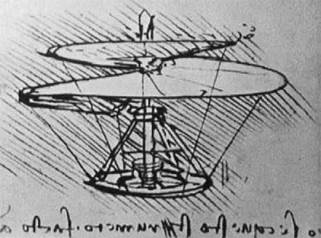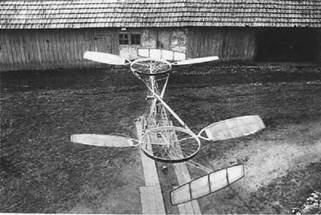Introduction
1.1 Looking Back
1.1.1 Early Years
The first foray into rotary-winged flight occurred around 400 bc with a toy known as the Chinese top. It was constructed with a central shaft to which was attached wings consisting of feathers or flat blades inclined to the rotation plane normal to the shaft. This was spun between the hands and by generating thrust flew for a short period of time. Jumping forwards to ad 1325, a Flemish manuscript contained the first known illustration of a helicopter rotor which was operated by the pulling of a string.
Just over 150 years later we encounter probably one of the most influential milestones in the work of Leonardo da Vinci. His famous design of a rotary-wing vehicle, see Figure 1.1, forms an ideal illustration of the origin of the term ‘helicopter’. It is commonly considered to be the combination of the words ‘helix’ and ‘pteron’ giving the concept of the ‘helical wing’.
In 1784, Launoy and Bienvenu built a mechanical model with two rotors. It was effectively the Chinese top but extended to a pair of rotors on the same axle but rotating in opposite directions. It was powered by a leaf spring and strings. It is similar to the coaxial configuration of more modern times.
In 1810, Sir George Cayley wrote an aeronautical paper preparing the ground for future helicopter development. He designed an air vehicle consisting of two pairs of contra-rotating rotors on either side of a canvas-covered central fuselage structure to generate lifting thrust. The rotor blades were inclined sectors with no noticeable aerofoil. Forward propulsion was provided by a pair of pusher propellers mounted at the rear. This design was the forerunner of many features of modern rotary-winged vehicles. The absence of a sufficiently powerful engine prevented the project from leaving the drawing board – let alone the ground.
The year 1878 saw Forlanini build a model powered by steam. It flew to a height of 40 feet for aperiod of20 seconds. Itwas impossible to achieve this by carrying a steam engine-because of the weight – so Forlanini devised a method whereby a sphere was positioned underneath the model and provided a storage vessel for the steam. This was then slowly tapped to obtain the required propulsive torque.
The lack of suitable power also hampered the work of Thomas Alva Edison. He initially conducted tests on rotors to examine the thrust v power performance. Finding this to be unfavourable he then focused on the engine and wrote of his attempts to use gun cotton in the
Basic Helicopter Aerodynamics, Third Edition. John Seddon and Simon Newman. © 2011 John Wiley & Sons, Ltd. Published 2011 by John Wiley & Sons, Ltd.
|
Figure 1.1 Leonardo da Vinci’s helicopter concept |
cylinder of an engine fired with a spark. He obtained good results but injured himself and one of his colleagues by singeing! Edison was not daunted and later work provided estimates of the required power/weight ratio that would allow a flyable helicopter to be achieved.
The absence of a powerful enough engine dogged the early 1900s; however, in September 1907 Louis Breguet achieved a milestone of the first man lifted with a tethered rotary-winged aircraft. The altitude was a mere 2 ft, but a 1 minute flight was the result. However, stability was obtained by four assistants actually holding the aircraft. He later built two other air vehicles but suffered from lack of sufficient power and lack of control both in flight and in landing.
November 1907 saw Paul Cornu achieving what is often considered to be the first ‘true flight’ of a helicopter. The vehicle rose to an altitude varying between 1 and 5 feet for a period of 20 seconds. It was fitted with two rotors of approximately 20 feet diameter mounted in a tandem layout – see Figure 1.2. Forward propulsion was provided by vanes positioned underneath the
|
|
rotor discs which deflected the rotor downwash backwards and downwards. The efforts of Breguet and Cornu highlighted the importance of stability and control in flight.
In 1909, a pioneering figure appeared who was to become very influential in the history of the helicopter. He was Igor Sikorsky, who initially built two helicopters which proved unsuccessful. This was the short-term result, but it taught the Russian about what to do and what not to do. In the interim period he moved to fixed-wing aircraft but 20 years later he was to bring the lessons of the past into focus and become a dominant figure in helicopter technology.
The year of 1912 saw the Danish aviator Ellehammer use cyclic pitch, successfully giving stable and controllable flight for the first time. The vehicle was lifted by two contra-rotating rotors on the same axle. The construction of both was of a ring to which was fitted the blades. The lower rotor was fitted with fabric to increase the lift force. Forward flight was aided by a conventional propeller.













